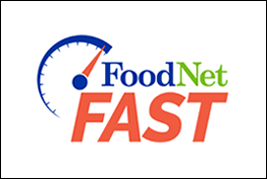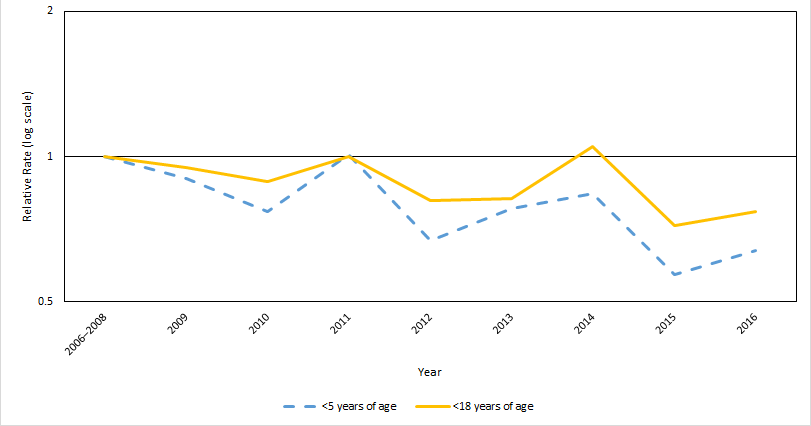2017 Preliminary Data: Tables and Figures

Take a look at FoodNet Fast, CDC’s interactive online program for information on cases of illness reported to FoodNet.
Each year, FoodNet reports on changes in the number of people in the surveillance area sickened with infections from pathogens transmitted commonly through food. The pathogens were detected by laboratory tests, including culture and culture-independent diagnostic tests. This year’s report summarizes 2017 preliminary surveillance data and describes trends since 2006 for infections monitored by FoodNet — Campylobacter, Cryptosporidium, Cyclospora, Listeria, Salmonella, Shiga toxin-producing Escherichia coli, Shigella, Vibrio, and Yersinia — as well as cases of hemolytic uremic syndrome (HUS) for 2016, the most recent year for which data are available.
Incidence trends
FoodNet uses a main-effects, log-linear Poisson regression (negative binomial) model to estimate changes in the incidence of infection.
FoodNet uses a main-effects, log-linear Poisson regression (negative binomial) model to estimate changes in the incidence of infection. The model adjusts for the increase in the number of FoodNet sites since 1996 and for variation in the incidence of infections among sites. The average annual incidence for 2015-2017 is used for comparisons. The model is used to calculate the estimated change in incidence (relative rate) between 2018 and the comparison periods, with 95% confidence intervals (CIs).

*The position of each line indicates the relative change in incidence of that serotype compared with 2006–2008. Actual incidences of these infections cannot be determined from this graph.
†Data for 2017 are preliminary.

*The position of each line indicates the relative change in incidence of that serotype compared with 2006–2008. Actual incidences of these infections cannot be determined from this graph.
†Relative rate for serotype I 13,23:b:-, the 12th most common serotype, was not assessed due to sparse data throughout time period.
§Data for 2017 are preliminary.
Download the data: Figure 2 – Relative rates of confirmed Salmonella infections with the top seventh through thirteenth Salmonella serotypes in 2017 compared with 2006–2008 average annual incidence, by year, FoodNet [XLS – 8 KB]

*The position of each line indicates the relative change in incidence of that serotype compared with 2006–2008. Actual incidences of these infections cannot be determined from this graph.
†Data for 2017 are preliminary.
Download the data: Figure 3 – Relative rate of confirmed STEC O157 infections in 2017 compared with 2006–2008 average annual incidence, by year, FoodNet [XLS – 8 KB]

*The position of each line indicates the relative change in incidence of that serotype compared with 2006–2008. Actual incidences of these infections cannot be determined from this graph.
†Data for 2016 are preliminary.
Download the data: Figure 4 – Relative rate of hemolytic uremic syndrome (HUS) cases in 2016 compared with 2006–2008 average annual incidence, by year, FoodNet [XLS – 8 KB]